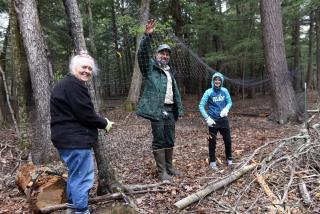The Radical Left Democrats shut down the government. This government website will be updated periodically during the funding lapse for mission critical functions. President Trump has made it clear he wants to keep the government open and support those who feed, fuel, and clothe the American people.
For information on recreation site status on National Forest System lands, please visit https://www.fs.usda.gov/visit.
Planting an outdoor classroom for the future

WISCONSIN—No tree can ever truly be replaced. However, replanting in areas where trees have blown down during storms can be a healing alternative for both the environment and community affected by severe weather. By the dozens, bands of nature enthusiasts came together at Trees for Tomorrow in Eagle River, Wisconsin, at the end of May.
Their goal? To plant 3,100 trees in areas where trees blew down in severe storms in summer 2021.
“When people come together like this to help restore our cherished natural resources on the public lands that we share, it sparks enthusiasm that inspires and benefits everyone,” said District Ranger Chad Kirschbaum, Chequamegon-Nicolet National Forest.
The forest and longtime partner Trees for Tomorrow are working together on an initiative to plant trees and sustainably manage Trees for Tomorrow’s campus forest. The nonprofit organization specializes in day and overnight environmental education programs for K-12 school groups, youth groups and families. The campus, located in Eagle River, includes national forest property under permit from the USDA Forest Service. The campus forest is used as an outdoor classroom and as a space to teach forestry curriculum.
Forest staff and Trees for Tomorrow employees began planning a harvest on the campus a few years ago. A community group provided an inventory of trees in the forest to help plan what, and where, the harvest would be most useful.
“This inventory allowed us to develop a prescription that described what type of trees and how many trees to harvest based on sustainable forest management principles,” said Kirschbaum. “As we were in the final stages of planning the project, the city of Eagle River was hit with a severe windstorm in the summer of 2021 which caused us to rethink our plan. The goals stayed the same, but we needed to remove more trees now for safety and think about what types of trees to replant.”
In hollowed spots in the forest where cedar, cherry, maple, oak, pine, spruce, tamarack and walnut trees once stood, there are now stands of newly planted seedlings. Some are of the same variety, while new species have been introduced to help account for changes in climate, disease and other factors that could affect the forest in the future.
The project would not have been completed without support, including from Blackwell Job Corps Civilian Conservation Center students who prepared the area by applying non-native invasive species treatments and volunteers who protected some of the new trees with wraps.
“Trees for Tomorrow and the USDA Forest Service had the joint goal of creating a safe environment for visitors to the Trees for Tomorrow campus and demonstrating sound forest management,” Kirschbaum said.
Over the next few years, the Forest Service and Trees for Tomorrow will continue to manage the entire campus in a sustainable manner to both enjoy and use as an educational tool. “As we do that, we will think about what species will grow best here in the next 50-100 years, given the changes in the climate that could occur,” Kirschbaum said.
This year, volunteers planted on the forest’s side of the Trees for Tomorrow campus. In 2024, volunteers will plant on the opposite side of campus. The plan also includes deer exclosures, an interpretive trail, educational signage and a physical outdoor classroom.
“We are looking forward to 2024 when there will be more opportunities for the community to become involved in another planting project,” Kirschbaum said.


